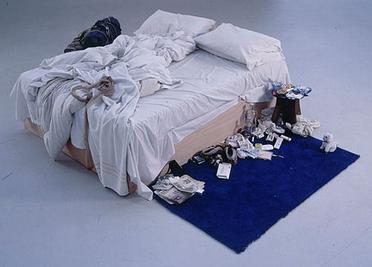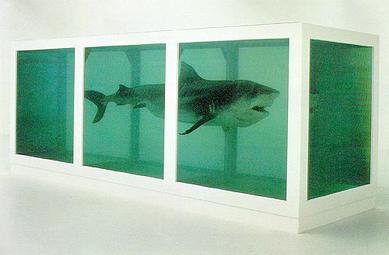 That a small group of Young British Artists (YBA) made an impact on the art scene in the UK and across the globe over the last 25 years is without question. Though, whether the public at large will, 10, 25 or 50 years from now (and beyond), recognize a Damien Hirst spin painting or Tracy Emin’s “My Bed” or a Sarah Lucas self-portrait — “The Artist Eating a Banana” springs to mind — remains an open question.
That a small group of Young British Artists (YBA) made an impact on the art scene in the UK and across the globe over the last 25 years is without question. Though, whether the public at large will, 10, 25 or 50 years from now (and beyond), recognize a Damien Hirst spin painting or Tracy Emin’s “My Bed” or a Sarah Lucas self-portrait — “The Artist Eating a Banana” springs to mind — remains an open question.
The group first came to prominence in the late 1980s, mostly through works and events designed to shock the sensibilities of the then dreadfully boring and insular British art scene. With that aim in mind they certainly succeeded, and some, notably Hirst, have since become art superstars. So, while the majority of artists never experience fame within their own lifetimes, many YBAs have managed to buck convention. Though, whether their art will live long and prosper is debatable.
Jonathan Jones over at the On Art blog, chimes in with a different and altogether kinder opinion.
From the Guardian:
It’s 25 years since an ambitious unknown called Damien Hirst curated an exhibition of his friends and contemporaries called Freeze. This is generally taken as the foundation of the art movement that by the 1990s got the label “YBA”. Promoted by exhibitions such as Brilliant!, launched into public debate by the Turner prize and eventually set in stone at the Royal Academy with Sensation, Young British Art still shapes our cultural scene. A Damien Hirst spin painting closed the Olympics.
Even where artists are obviously resisting the showmanship and saleability of the Hirst generation (and such resistance has been the key to fashionable esteem for at least a decade), that generation’s ideas – that art should be young and part of popular culture – remain dominant. Artists on this year’s Turner shortlist may hate the thought that they are YBAs but they really are, in their high valuation of youth and pop. If we are all Thatcherites now, our artists are definitely all YBAs. Except for David Hockney.
From “classic” YBAs like Sarah Lucas and Marc Quinn to this year’s art school graduates, the drive to be new, modern, young and brave that Freeze announced in 1988 still shapes British art. And where has that left us? Where is British art, after 25 years of being young?
Let’s start with the best – and the worst. None of the artists who exploded on to the scene back then were as exciting and promising as Damien Hirst. He orchestrated the whole idea of a movement, and really it was a backdrop for his own daring imagination. Hirst’s animals in formaldehyde were provocations and surrealist dreams. He spun pop art in a new, visceral direction.
Today he is a national shame – our most famous artist has become a hack painter and kitsch sculptor who goes to inordinate lengths to demonstrate his lack of talent. Never has promise been more spectacularly misleading.
And what of the mood he created? Some of the artists who appeared in Freeze, such as Mat Collishaw, still make excellent work. But as for enduring masterpieces that will stand the test of time – how many of those has British art produced since 1988?
Well – the art of Sarah Lucas is acridly memorable. That of Rachel Whiteread is profound. The works of Jake and Dinos Chapman will keep scholars chortling in the library a century or two from now.
What is an artistic masterpiece anyway? Britain has never been good at creating sublime works in marble. But consider the collection of Georgian satirical prints in the Prints and Drawings room at the British Museum. Artists such as Gillray and Rowlandson are our heritage: rude, crude and subversive. Think about Hogarth too – an edgy artist critics snootily dismiss as a so-so painter.
Face it, all ye who rail at modern British art: YBA art and its living aftermath, from pickled fish to David Shrigley, fits beautifully into the Great British tradition of Hogarthian hilarity.
The difference is that while Hogarth had a chip on his shoulder about European art lording it over local talent, the YBA revolution made London world-famous as an art city, with Glasgow coming up in the side lane.
Warts and all, this has been the best 25 years in the history of British art. It never mattered more.
Read the entire article after the jump.
Image: My Bed by Tracey Emin. Courtesy of Tracey Emin / The Saatchi Gallery.

 Regardless of what you may believe about Damien Hirst or think about his art it would not be stretching the truth to say he single-handedly resurrected the British contemporary art scene over the last 15 years.
Regardless of what you may believe about Damien Hirst or think about his art it would not be stretching the truth to say he single-handedly resurrected the British contemporary art scene over the last 15 years.